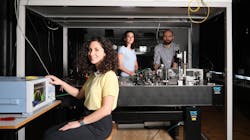Researchers at the École polytechnique fédérale de Lausanne (EPFL; Lausanne, Switzerland) have come up with a new mid-IR supercontinuum light source that can detect greenhouse and other gases, as well as molecules in a person’s breath.1 The compact system, which is the size of a small suitcase, contains just two parts: a 2070-2090 nm wavelength-tunable femtosecond fiber pump laser together with a photonic chip measuring a few millimeters across.
The mid-IR spectrum is especially useful for scientists because light in this wavelength region can detect organic particles that play an important role in the environment and in human health. Until now, however, mid-IR laser systems have proven difficult to transport because they involve complex, damage-prone hardware.
The new technology, developed by researchers could be a game-changer. The EPFL team took a commercially available fiber laser and combined it with a micrometer chip with a silicon nitride (Si3N4) nonlinear optical waveguide 1 µm wide by 0.5 mm long to reliably generate supercontimuum mid-IR light. They then added a spectrometer to demonstrate the potential of this light source, successfully detecting the presence and concentration of acetylene, a colorless and highly flammable gas.
The output of the chip, light in the 3–4 µm range, retains 30% of the input signal strength, and the researchers can even tune the wavelength of the light by adjusting the waveguide's geometry.
"This device sets a new benchmark for efficiency," says Davide Grassani, one of the researchers. "This is the first time anyone has created a fully integrated spectroscopic laser source. It does away with the painstaking process of precisely aligning all the parts in a conventional laser system."
"Once we've developed the system further, we could well see on-chip detectors that scientists can easily carry out into the field," says Camille Brès, project coordinator and head of the Photonic Systems Laboratory, part of EPFL's School of Engineering.
Source: https://actu.epfl.ch/news/detecting-pollution-with-a-compact-laser-source/
REFERENCE:
1. D. Grassani et al., Nature Communications (2019); https://doi.org/10.1038/s41467-019-09590-3.

